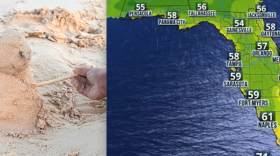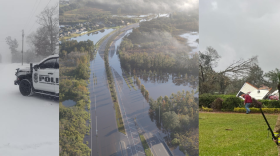WATER QUALITY REPORT FOR OCT. 8, 2023
Southwest Florida’s water-quality environment has been known lately for killer hurricanes, red tides that kill thousands of fish, submerged Burmese pythons that can rush out and eat your dog, and blue-green algae outbreaks that foul half of the Caloosahatchee River.
So it is very welcome, indeed, when a fun and happy environmental news event, with a great ending, is hand-delivered to you by the Journalism gods.
Happened to me last week when a one-year-old green turtle meant to live in saltwater had instead, apparently, made it 12 months in a freshwater pond near a Fort Myers-area RV park.
Sure, somebody could have hand-raised the green turtle from a hatchling to one year old – illegal on many levels by the way – and then released it in the pond where it was quickly found.
But that pathway into the pond was not mentioned by those who investigated the incident, checked the health of the flipper-clad greenie, and released it into a saltwater lagoon to continue its journey to adulthood in the right type of water. It needs to Live A Salt Life.
What was mentioned was Hurricane Ian. The female saltwater turtle was one year old, and Ian hit here one year ago. It’s easy to imagine Ian’s winds and water sweeping the animal off the beach as a dollar-coin sized hatchling, then the retreating storm surge dropped off Little Leonardo at the pond to find a tiny recreational vehicle to call home.
Marine sea turtles need seawater, physiologically, to survive. After hatching, they head to the ocean and drink saltwater. This helps activate their specialized salt glands, which aid in excreting excess salt, maintaining ion and a water balance vital for their health.
So how did our federally endangered baby green turtle adapt for 12 months to a freshwater pond, and grow far larger than an adult’s hand while there?
I have no clue.
It was the wrong type of water, the quality of the region’s water was horrible all winter long from 2022-23, and the reports found red tide offshore fouling the oceans and blue-green algae clogging and stinking up freshwater lakes and ponds throughout the region.
The Teenage Mutant Ninja Turtles would be proud. And word is that the steroid-looking, ripped-and-mean turtle mascot at the University of Maryland is intimidated by our greenie, who must have decided a RV Park pond was great for a summer 2023 staycation. Or the turtle spent all year Breaking Bad in an RV.

I could flipper around these jokes around all night. I’m swimming in water-quality humor. Maybe our little turtle met the Geico gecko and they just had a Summer of Love.
Dumb jokes, sure, but I’ll take the opportunity to make them because other than cute sea turtle stories, this summer's environmental news has been killer - deaths from heat, wildfires, floods, earthquakes, hurricanes - so much tragedy that my son said to me last night: “Dad, how come all I ever see on the news anymore are dead bodies?”
I was at a loss for fatherly words of solace so I just gave him a long, silent hug.
Then I said: “Did you hear the one about the sea turtle who lived near some vans down by the pond … “
RED TIDE
The red tide organism, Karenia brevis, was observed at background concentrations in two Southwest Florida samples collected over the past week. Other samples collected statewide by the Florida Fish and Wildlife Conservation Commission did not contain K. brevis
The organism was observed at background concentrations in two samples off of Sarasota County. That’s it.
No reports of fish kills suspected to be related to red tide were received over the past week.
No reports of respiratory irritation suspected to be related to red tide were reported in Florida over the past week.
No animals died of red tide toxins this week, according to the Clinic for the Rehabilitation of Wildlife on Sanibel Island, which is still rebuilding from the ravages of Hurricane Ian last year.
BLUE-GREEN ALGAE
There were 39 reported site visits in the past seven days with 39 samples collected. Algal bloom conditions were observed by samplers at four of the sites, none in Southwest Florida.
Satellite imagery of the Caloosahatchee River watershed shows no visible bloom potential, according to the Florida Department of Environmental Protection.
Satellite imagery of Lake Okeechobee shows low to moderate bloom potential on approximately 20% of the lake, primarily in the western half.
The FDEP says it is important to remember the blue-green algae potential is subject to change due to rapidly changing environmental conditions or satellite inconsistencies.
But for now, and for another week, it looks as if we have skirted a complete outbreak of blue-green algae on the Caloosahatchee River – but there are still several more warm weeks so there is nothing for certain yet.
What is red tide?
Red tide is one type of harmful algal bloom caused by high concentrations of the toxic dinoflagellate K. brevis, which is a type of microscopic algae found in the Gulf of Mexico. Red tide typically forms naturally offshore, commonly in late summer or early fall, and is carried into coastal waters by winds and currents. Once inshore, these opportunistic organisms can use nearshore nutrient sources to fuel their growth. Blooms typically last into winter or spring, but in some cases, can endure for more than one year.
Is red tide harmful?
K. brevis produces potent neurotoxins (brevetoxins) that can be harmful to the health of both wildlife and people. Wind and wave action can break open K. brevis cells and release toxins into the air. This is why you should monitor conditions and stay away from beaches where red tide is in bloom. People in coastal areas can experience varying degrees of eye, nose and throat irritation during a red tide bloom. Some individuals with chronic respiratory conditions like asthma or chronic lung disease might experience more severe symptoms. Red tide toxins can also affect the central nervous system of fish and other marine life, which can lead to fish kills.
What causes red tide?
A red tide bloom develops naturally, but recent studies have discovered mankind's infusion of other nutrients into the mix can make the red tide last longer or get stronger. But biology (the organisms), chemistry (natural or man-made nutrients for growth) and physics (concentrating and transport mechanisms) interact to produce the algal bloom. No one factor causes the development of a red tide bloom.
What is blue-green algae?
Blue-green algae, also known as cyanobacteria, are a group of organisms that can live in freshwater, saltwater or brackish water. Large concentrations, called blooms, can change the water color to blue, green, brown, orange or red. Some cyanobacterial blooms can look like foam, scum, or mats on the surface of freshwater lakes and ponds. As algae in a cyanobacterial bloom die, the water may smell bad
Is blue-green algae harmful?
Different types of blue-green algal bloom species can look different and have different impacts. However, regardless of species, many types of blue-green algae can produce toxins that can make you or your pets sick if swallowed or possibly cause skin and eye irritation. The Florida department of Environmental Protection advises staying out of water where algae is visibly present as specks or mats or where water is discolored. Pets or livestock should not come into contact with algal bloom-impacted water or with algal bloom material or fish on the shoreline. If they do, wash the animals immediately.
What causes blue-green algae?
Blue-green algae blooms occur when the algae that are normally present grow in numbers more than normal. Within a few days, a bloom can cause clear water to become cloudy. Winds tend to push some floating blooms to the shore where they become more noticeable. Cyanobacterial blooms can form in warm, slow-moving waters that are rich in nutrients. Blooms can occur at any time, but most often occur in late summer or early fall.
If any major type of water quality alert is issued, you can find the details here in WGCU’s Water Quality Report.
Environmental reporting for WGCU is funded in part by VoLo Foundation, a non-profit with a mission to accelerate change and global impact by supporting science-based climate solutions, enhancing education, and improving health.
Sign up for WGCU's monthly environmental newsletter, the Green Flash, today.
WGCU is your trusted source for news and information in Southwest Florida. We are a nonprofit public service, and your support is more critical than ever. Keep public media strong and donate now. Thank you.








